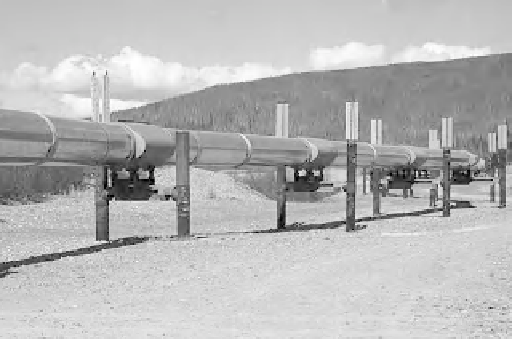Geology Reference
In-Depth Information
14.7.3. Pipelines and Permafrost
The construction of pipelines through permafrost terrain further illustrates the complex-
ity of frost heave and related permafrost problems. Inevitably, oil is “warm” and the ease
of transmission through a pipeline varies with viscosity. The classic example was the con-
struction of the Trans-Alaska Pipeline System (TAPS) from Prudhoe Bay on the North
Slope to Valdez on the Pacifi c Coast between 1974 and 1977. This pipeline utilized many
procedures designed to minimize permafrost problems (Heuer et al., 1982; Metz et al.,
1982). Approximately half the route was elevated on vertical support members (VSMs),
many with cooling devices (“heat tubes”) to prevent heat transfer from the warm pipe to
ice-rich (i.e. thaw-sensitive) permafrost (Figure 14.12). In Canada, a smaller oil pipeline
from Norman Wells southwards has been in operation since 1985. Although this pipe is
buried, monitoring of thaw penetration and surface settlement indicates that it has not
experienced thaw-subsidence problems to the same extent as the Alaska line (Burgess and
Smith, 2003). This is probably because it was designed to operate at, or close to, prevailing
ground temperature. Instead, the main terrain problems associated with this pipeline have
centered upon the stability of wood-chip-covered embankments along the right-of-way,
and at stream crossings (Burgess and Harry 1990).
The construction of buried chilled gas pipelines presents other problems that are still
not adequately resolved. For security reasons, the pipe must be buried wherever possible
and the colder (denser) the gas, the easier is its transmission. The problem, therefore, is
one of prolonged frost heave adjacent to the pipe (see Williams, 1979, pp. 75-82; Smith
and Williams, 1990) with the possibility of eventual rupture (Figure 14.13). This might
occur in the discontinuous permafrost zone wherever the pipe crosses unfrozen ground
and where there would be relatively unlimited moisture migration towards the cold pipe.
Equally, when the pipe passes from unfrozen (stable) to ice-rich (unstable) terrain, or
vice-versa, thaw settlement may result.
The problems of operation of chilled gas pipelines are well illustrated by the 30-year
Russian experience in northwest Siberia. The large gas fi elds of Yamburg, Urengoy,
and Medvezh'ye now constitute an important energy source for western Russia and,
Figure 14.12.
The Trans-Alaska Pipeline is elevated above ground for much of its route. This
photograph, from near Fairbanks, shows the elevation of the pipe above the ground (
2.5 m), the
cooling devices on the VSMs, and the gravel access and maintenance pad. The photograph was
taken in May 1980.
∼

